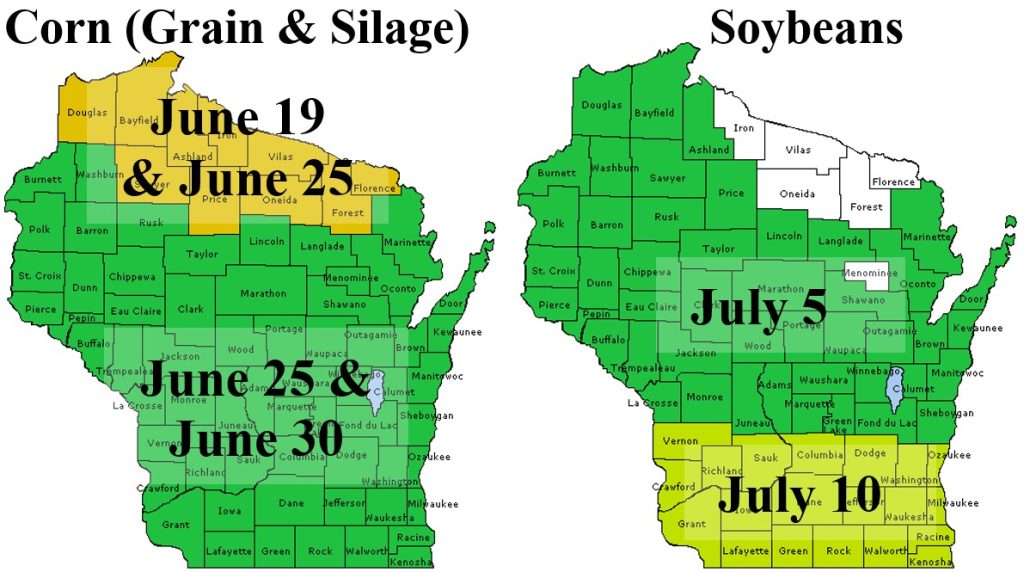This article originally appeared on the UW–Madison Agricultural and Applied Economics website.
Wisconsin’s wet spring has slowed planting for many farmers and provided poor conditions for making hay. As a result, some farmers will be claiming prevented plant and many will be looking for more or better quality forage. This bulletin reviews crop insurance rules to help farmers understand their options for using prevented plant acres for forage production.
For example calculations and explanations of prevented plant options for hypothetical cases to help you further understand your options, see Prevented Plant Example Calculations for Wisconsin in 2024.
Key Dates for Filing Prevented Plant

Dates for filing prevented plant vary by crop and county (see maps above). Farmers must contact their insurance agent within 72 hours of the dates on these maps if they will be unable to plant. In the far north, the dates are June 19 for corn for grain and June 25 for corn silage and in the south, June 25 for corn for grain and June 30 for corn silage. For soybeans, the dates are July 5 for most of the state, but July 10 in the far south. Small areas do not qualify for prevented plant; to qualify an area must exceed 20 acres or 20% of the unit’s acreage (20/20 rule). Also, your planted acres plus prevented plant acres for a crop cannot exceed the maximum acres you planted of that crop in any of the last 4 years (1 in 4 rule).
Farmers have three options for using prevented plant acres for forage:
1) Take the full Prevented Plant (PP) indemnity equal to 55% of your guarantee.
You can leave these acres idle (weed management still recommended), or you can plant a cover crop for forage, including establish alfalfa. Rules were changed and now you can make hay, graze, or cut these acres for silage, haylage or baleage at any time, but you still cannot harvest them for grain or seed. However, these acres must be managed as a cover crop, following agricultural expert guidelines for seeding rates, input use and termination dates. See NRCS Wisconsin Agronomy Technical Note 7 (see Additional Resources at the end). In most cases, cover crops may use different seeding rates and do not use fertilizer or chemicals. Contact your insurance agent to clarify or you may inadvertently move your coverage into option 2. Note, corn CANNOT be a cover crop; if you want to plant corn, use option 2 or 3.
2) Take a reduced Prevented Plant indemnity equal to 35% of your full PP indemnity.
On these acres, you can plant a second crop and manage it as a crop (not a cover crop), including forage, establish alfalfa or other perennial crop, or harvest for grain or seed as you want. If you insure the second crop (such as with a forage seeding policy), you must manage it according to crop insurance rules for that crop. Again, contact your insurance agent.
3) Leave the acres uninsured
You pay no premiums, will receive no indemnities, but have no restrictions on planting, harvesting, grazing or managing these acres for forage.
Always contact your crop insurance agent if you want to claim prevented plant and, once a claim is filed, clarify with them regarding insurance rules before taking action on these acres.
Comments
- Loss of Enterprise Units: To be eligible for enterprise units, a farmer must plant 20 acres or 20% of planted acres in at least two sections. Prevented plant acres do NOT count in this calculation and so a farmer may lose eligibility for enterprise units, and thus have to pay larger premiums for all their insured acres.
- Yield History Impacts: Acres claimed for reduced prevented plant (option 2) use 60% of the yield from your planted acres for future yield history calculations, likely reducing it. Acres claimed for full prevented plant (option 1) and uninsured acres (option 3) do not affect your yield history.
- Commodity Program Impacts: Prevented plant payments do not affect Agricultural Risk Coverage (ARC) or Price Loss Coverage (PLC) payments and prevented plant acres are considered planted for calculation of base acres.
- Conservation Program Impacts: Conservation payments do not affect prevent plant payments. Also, if you plant cover crops on prevented plant acres, you can still be eligible for cost-share support from NRCS or other cost-share options.
- Terminating 2023 Cover Crops: A cover crop established in the fall of 2023 must be terminated within 12 months (fall of 2024) or it is considered an established crop. Corn or soybeans planted in 2025 into an established cover crop will not be insurable.
- Alfalfa Establishment: Growers can establish alfalfa with or without a nurse crop on prevented plant acres (options 1 or 2) and have it ready for production in 2025.
- Agronomic Considerations: Agronomic considerations such as switching corn maturity dates or from grain to silage should be part of the decision. See the Extension corn and soybean agronomy web pages.
Additional Resources
Late and Prevented Plant Example Calculations for Wisconsin: https://aae.wisc.edu/pdmitchell/2024/06/24/prevented-plant-example-calculations-for-wisconsin-in-2024/
RMA Prevented Planting Coverage Q and A: https://www.rma.usda.gov/News-Room/Frequently-Asked-Questions/Prevented-Planting-Coverage
RMA First and Second Crop Rules: https://www.rma.usda.gov/Fact-Sheets/National-Fact-Sheets/First-and-Second-Crop-Rules
RMA Prevented Planting Insurance Provisions: Flood: https://www.rma.usda.gov/en/Fact-Sheets/National-Fact-Sheets/Prevented-Planting-Insurance-Provisions-Flood
NRCS Wisconsin Agronomy Technical Note 7: https://efotg.sc.egov.usda.gov/references/Delete/2015-12-19/Aronomy_7_Technical_Note.pdf




